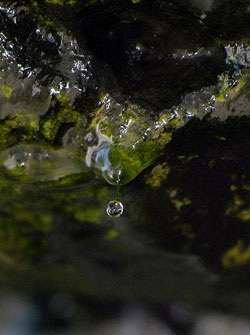
Cultural Feature: Where are the Waters of Kāne?
The life-giving fresh waters of Kāne have sustained the Hawaiian Islands for millions of years and provided an especially precious resource on Nihoa. The following chant—the second verse of a longer piece—asks the question, "Where are the Waters of Kāne?" In the ensuing answer, we find that the Northwestern Hawaiian Islands are home to the Waters of Kāne. In this answer, we see the interaction between water and archipelago, telling of fresh water found "where Sun sets," and where "the cloudbanks rest on Ocean's breast." Those clouds are said to "rise and billow at Nihoa" and are found at the "base of Lehua" (an island near Niʻihau).
"E ui aku ana au iāʻoe,
Aia i hea ka Wai a Kāne?
Aia i Kaulanaakalā
I ka pae ʻōpua i ke kai
Ea mai ana ma Nihoa
Ma ka mole mai o Lehua;
Aia i laila ka Wai a Kāne."
Nihoa is located 130 miles from Niʻihau and is the tallest of the Northwestern Hawaiian Islands. It consists of approximately 170 acres of rocky, wind-swept, and sloped terrain. However, it once supported a permanent population of Native Hawaiians who successfully developed approximately 16 acres of sweet potato agricultural complexes that sustained Nihoa's population over the course of 700 years: a feat only made possible by the Waters of Kāne.
Sources:
Emerson, Nathaniel B (1998). Unwritten Literature: The Sacred Songs of the Hula. Honolulu: Mutual Publishing.
Pukui & Elbert (1957) Hawaiian Dictionary. Honolulu: University of Hawaiʻi Press.
Paul L. Cleghorn. The Settlement and Abandonment of Two Hawaiian Outposts: Nihoa and Necker Island (Honolulu: Bishop Museum Occasional Papers 28:35-49, February 1988).

